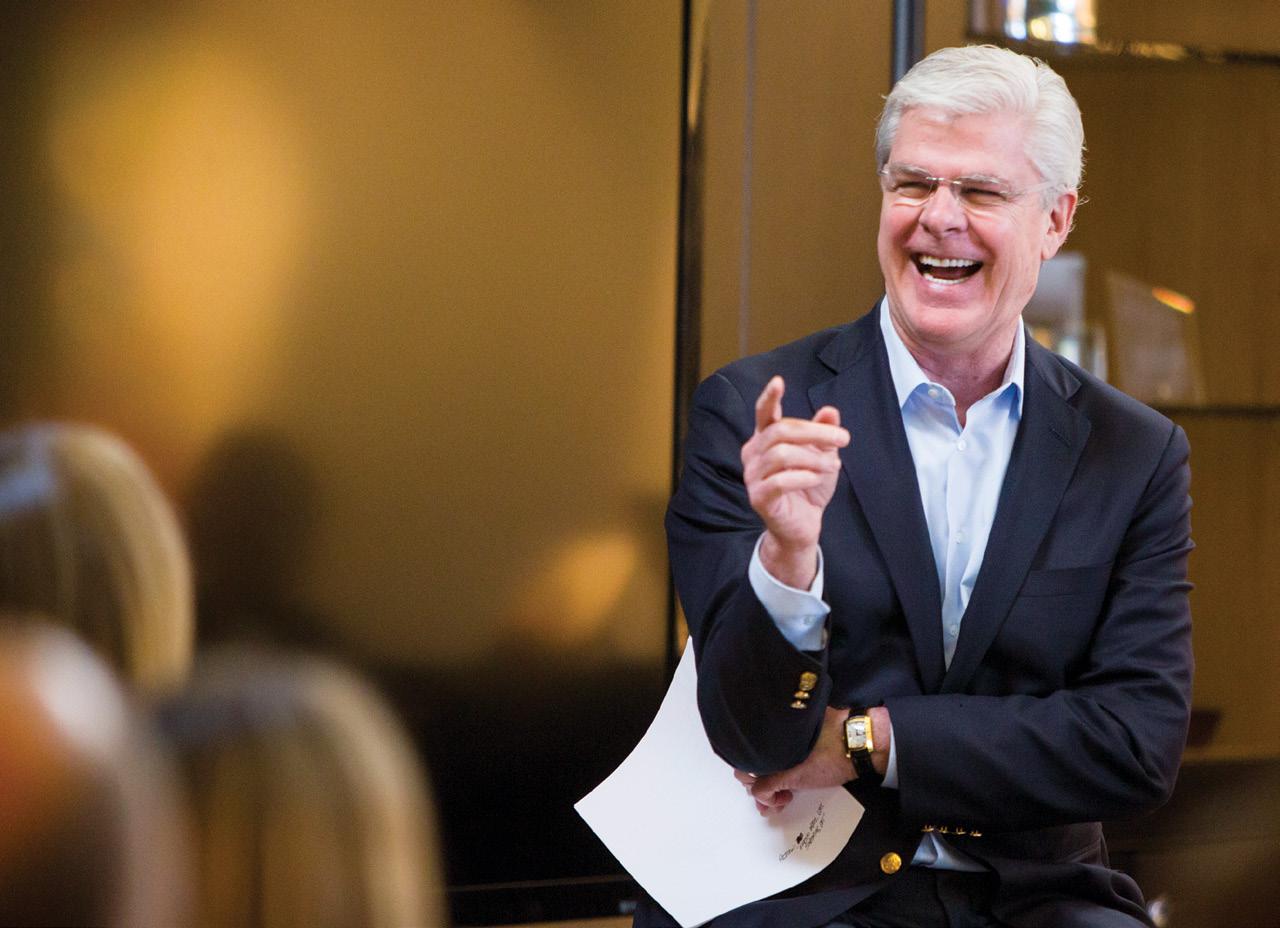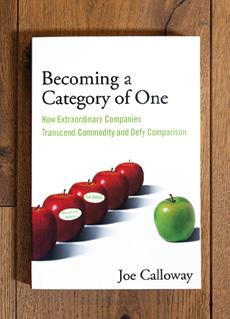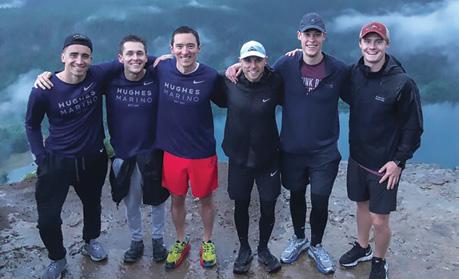WORK+SPACE



Apositive shift in momentum has the power to change the course of a business, both from a team dynamic and a profitability standpoint. But how do we create that momentum in the first place, when our days in the fast-paced business world are filled with deadlines, challenges and unchartered territory?
In this issue of Work+Space ® , we share a few guiding strategies to answer that question, as we highlight the positive energy of high-performing teams, forward-thinking leadership and cost efficiencies.
On the following pages, you’ll find an insightful Q&A with business strategist and author Joe Calloway, focused around the power of competitive advantage, simplicity and consistency in business. From a culture aspect, we examine the connection between high performing teams and the high nurturance needed to achieve greatness. Additionally, we handpicked nine “HM-isms”—unique motivational concepts and phrases—that we believe can uplift your team and can be applied to any business setting. Think of this article as an inspirational cheat sheet for your next company meeting!
In terms of the bottom line, businesses must ensure the budget of a company is aligned with its goals. This also means identifying any unnecessary expenditures, and one place to begin is through reassessing your real estate. Luckily, you’ve come to the right source, as we have 30+ years of experience around representing companies in their real estate transactions. From naming key expense reduction strategies, to noting five mistakes businesses make with their commercial leases, we cover many aspects of real estate that we hope you will find helpful when looking for ways to cut costs and ensure you are making the right decisions for your team.
In an era where business owners are rolling up their sleeves to get back to the basics of business with their highperforming teams, we hope this issue of Work+Space ® sparks new ideas and positive momentum to set you up for success in the years to come.
Jason Hughes Chairman & CEO
Hughes Marino
Shay Hughes President & COO
Hughes Marino
A publication of Hughes Marino
BUSINESS + REAL ESTATE + DESIGN + CULTURE + CONSTRUCTION
Hughes Marino is a global corporate real estate firm that specializes in representing tenants and buyers—not landlords. We provide a full suite of services for occupiers of commercial real estate on an integrated and turnkey basis. Whether you need help with real estate strategy, site selection, and negotiations around renewal, expansion, relocation or subleasing, construction project management, planning and design, corporate culture, and operating expense review and/or lease administration, Hughes Marino can address any problem or opportunity for companies of any size, any industry and at any stage of their real estate life cycle—anywhere on the planet.


Business strategist, author and long-time Hughes Marino coach Joe Calloway recently sat down with our team for a Q&A that left us inspired and wanting to share his wisdom with our clients and friends. Centered around one of many of Calloway’s books, Becoming a Category of One— which is also a favorite read of ours—we discussed the timeless principles for a thriving business, the evolving customer experience and the role of culture in organizational success.
QWhile Becoming a Category of One was originally published over two decades ago, the learnings and insights couldn’t be truer today. If you were to write another chapter, what would it be about?
AThe importance of being easy to work with. During my speeches at business conventions and events, I would ask business leaders: How much of a competitive advantage would it be if you were known in your industry, amongst all of your competitors, as the easiest to do business with? Of course, everyone emphatically agreed it would be an extreme competitive advantage. I’m an investor and work with a handful of startups, and the one thing that startups and major successful companies all have in common is that they make something easier to do. Take Uber—a mega-company now. What do they do? They make it easier to get a ride. Companies should ask themselves, do I make something easier to do and is my company/product easy to work with? To the extent that we can all make something easier to do, that is actually value creation, because the market values that tremendously.
HOW MUCH OF A COMPETITIVE ADVANTAGE WOULD IT BE IF YOU WERE KNOWN IN YOUR INDUSTRY, AMONGST ALL OF YOUR COMPETITORS, AS THE EASIEST TO DO BUSINESS WITH?" “
Q
What do you think has changed most about the customer experience since you wrote the book?
AThere are a number of things that have changed, but the one that really comes to mind is time. More than ever. When does the customer want it? They want it now. Nobody wants to wait. If you make somebody wait unnecessarily in their mind, that's a big, big competitive disadvantage. Take Amazon, for example. I order something in the morning and immediately receive an email with a delivery window for the same afternoon. That sets an expectation. And companies may say “Yeah, but I'm not Amazon, our expectations are different.” But customers might subconsciously be thinking, “If Amazon can get me that the same day, what's up with you guys? Why have I been waiting for a return call for two days?” I think that's been changing customer expectations immensely.
Q
What advice would you offer to leaders as they try to maintain their culture while navigating growth?
AI think it's a real challenge and a real opportunity, as most challenges stem from the culture part of the equation. One of the businesses that I focused on in Becoming a Category of One was Tractor Supply Company, because they are a very culture-driven business. I asked Joe Scarlett, company president at the time, how he dealt with maintaining their culture as they acquired new companies and hundreds of new employees over the years. I loved his answer, and will never forget what he said: “You know, the fact is we just talk about this stuff all the time.” I think this rings true with Hughes Marino as well.
Hughes Marino does a great job with building, strengthening and maintaining its culture. You are great storytellers. You can recite your 10 core values, which is great as a baseline, but in team meetings you also discuss how you deliver excellence to clients and live those core values, which paints a great picture of what you’re all about. Your team members really get it and really start to internalize it.
Q
What advice would you offer to leaders as they navigate balancing hybrid and in-office work to create policies that balance team culture and productivity?
AOverall, in-office/in-person work has its very strong advantages given the power of collaboration, mentorship, relationship-building, etc. And those are all fundamental keys to creating a strong brand, a strong culture and a stronger company. But with that said, the important thing is to examine the different pieces involved. Companies need to find their own balance between what makes the most sense for their customers, the type of business they are and their workforce. All three need to be considered with the backdrop of the benefits of being in-person.
QWhat do you think is the biggest brand builder for companies?
AIn my experience, one of the greatest brand builders in the world is consistency of performance, and one of the greatest brand killers is inconsistency of performance. It’s not easy to have a high standard company-wide. We've all done business with some companies that have employees that fall short of their brand standards. That's a brand killer. It can’t depend on which employee you get. Yes, we should celebrate when we get a letter or an email from a customer complimenting a teammate for going above and beyond. But what we should focus on even more is receiving letters that say, I just want to let you know that no matter who I deal with in your company, it's always a great experience. Boom. That's the best. To me, one of the foundations of becoming a category of one brand is to strive for that consistency of performance.
QCurrently, what brands do you believe rise to the level of a category of one? Who’s doing it really well?
AI might surprise you with this because I'm going to give you kind of an everyman's brand—Discount Tires. What this very successful company does that has made them a category of one to me is a lesson for any business, anywhere, which gets to the core of brand strength. While I have done business with other tire stores over the years, someone referred me to Discount Tires, and now any time anyone in my family needs tires, I go there. They sell pretty much the same kind of tires as everybody else and their pricing is also pretty much the same as everybody else. But one differentiator is that they make it super easy to make an appointment online, and they honor that appointment in-store, which is a big deal. Then, when I arrive at the store, a very personable associate acknowledges me very quickly, and if they're behind, they will still give me an immediate response, so I know I'm not being ignored. They're very professional, and they know their stuff. And they always have me out of there in 45 minutes to an hour. But here's the key—every time I go, even if I get a different person, I get the same experience. Not that they're robots. They don't have scripted, clichéd lines that they use. Even when I go to a different location, a different store—same experience. Brand consistency at its finest. That’s a category of one!
IN MY EXPERIENCE, ONE OF THE GREATEST BRAND BUILDERS IN THE WORLD IS CONSISTENCY OF PERFORMANCE, AND ONE OF THE GREATEST BRAND KILLERS IS INCONSISTENCY OF PERFORMANCE." “
Our thought-provoking conversation with Joe Calloway was a testament to the power of the fundamentals of business— ease, consistency and simplicity. In an era of constant change, these elements remain the key to success. As Hughes Marino and many other businesses continue to grow and evolve, the lessons from Becoming a Category of One serve as an essential guide to business success, no matter what industry you’re in or who your customers are! ☐
Joe Calloway is an International Speakers Hall of Fame inductee and a best-selling author of nine books who has coached businesses for over 30 years, consulting with Fortune 100 companies and thousands of companies over his career to help them create and sustain success. Joe is also an investor in several growing and industry-leading companies, and resides with his family in Nashville, TN.


By Shay Hughes
While one might not always equate ‘nurturance’ to a business setting, it is a critical piece of the puzzle in building a team’s chemistry, confidence and drive to succeed.”
Much like in sports, when it comes to growing a business, there’s no denying the ultimate goal is to win, whether that means winning a championship ring or achieving a high ROI for your investors. While winning on any front demands unmatched grit, discipline and drive from every individual on the team, it also requires a high level of nurturance and connectivity to bring out the best of any championship team.
Anyone who is familiar with Hughes Marino knows how dedicated, hard-working and devoted our team is. With one of our core values being, “delivering excellence in everything we do,” we take pride in our high-performing, high-caliber team. But with high expectations, we know we need to find a balance to ensure our team feels fulfilled and valued in the workplace, something we consider on a daily basis.
Always looking for opportunities to invest in our team’s personal development, we sought out business coach Mike Robbins to mentor our team early on in our growth. As a former pro-baseball player turned best-selling author, Mike Robbins has coached some of the largest companies in the world, including Google, Microsoft and Coca-Cola, as well as many of the nation’s top professional sports teams. Mike often draws on his firsthand experiences from the sports world to convey the critical aspect behind team dynamics and culture, which can benefit and fuel the morale at any company.
When Mike first introduced the concept of “high expectations, high nurturance” to our own team, we loved it so much we made it one of our HM-isms. Mike shared that all companies with a strong culture are dedicated to excellence, which in turn means that they demand a lot from their team members. Why is this a good thing? Settling for mediocrity will not help individuals to grow, nor will it help companies to thrive. Creating an environment where high expectations are the norm, while also supplying the high nurturance needed to meet those expectations, is vital in creating a strong company culture and a thriving team.
Winning the World Series in 2010, 2012 and 2014 was no accident for the San Francisco Giants, which Mike highlights as an ultimate example of a high expectations, high nurturance success story. It was the direct result of the intentional effort in mastering the perfect balance of expecting top performance while also providing a supportive atmosphere for teammates to be themselves, make mistakes and grow together. Their team wasn’t made up of individual superstars, like one would expect. But together, their tight-knit team bonded together through a culture of trust, connection and support to win the most coveted title in baseball three times within a span of five years.
While one might not always equate “nurturance” to a business setting, it is a critical piece of the puzzle in building a team’s chemistry, confidence and drive to succeed. Plus, it makes coming into the office a whole lot more fun and fulfilling when you have a team that truly likes and cares about one another. There will always be times in any rewarding career path when we come across an obstacle or even failure, but overcoming those challenges, surrounded by people who genuinely care about each other and have fun together makes all the difference.
During one of our team meetings, Mike shared a perfect example of success through nurturance when he described what he witnessed by the Houston Astros’ team and their manager A.J. Hinch in the 2017 World Series. In Game 5, outfielder George Springer missed a catch, allowing the Dodgers to take the lead. Despite the critical mistake, Hinch and the team rallied around Springer instead of tearing him down. One inning later, he redeemed himself by hitting a home run to tie the game. Despite making an error that could potentially cost the Astros a game, the team provided support and encouragement, which blossomed into a redeeming moment to eventually help to win the World Series title.
On multiple occasions, I’ve personally seen our team rally around teammates who are enduring a difficult time in their lives, and I can guarantee you those same teammates have also rallied for others, too. A culture of nurturance leads to tight-knit teamwork and meaningful bonds that balance out the highs and lows of whatever comes our way.
People who lack proper management and coaching will most often flounder, which is terrible for productivity and efficiency, and a major reason why great coaching is a driving element of success. One example of great coaching that Mike shares is what he witnessed when working with a specific team at Google that was tasked with a high-stakes project under a tight deadline. The team leader made a point to always prioritize creating a nurturing environment, despite the great pressure of working at the innovative tech giant. The leader built connection through organizing regular team lunches and intentionally fostered a culture of open communication with continuous check-in meetings where team members would feel safe in voicing concerns and admitting mistakes, while also celebrating small wins. This emphasis on nurturance intensified the team’s drive to succeed, as they all felt extremely supported, valued and fulfilled by their team leader, which ultimately led to a project that was delivered ahead of schedule and exceeded all expectations.
We’ve made it a point in our company to have regular coaching sessions to share valuable insights with the entire team. From all-team meetings where we share stories about having a growth mindset and overcoming challenges, to our advisory team’s “bootcamp” sessions, where attendees are infused with decades of experience from the most successful advisors in the nation during their first few years of the business, at our core we believe strongly in reinvesting in the personal development of every individual on our team. In addition to internal coaching, we are always looking for inspiration from outside sources.
From business coaches like Mike, to inspiring articles and speeches, to movies and books, we make a point to share and discuss coaching concepts with our team on a very regular basis. Our constant focus on the growth of our team creates a winning mindset that unites us in providing exceptional, best-in-class service to our clients.
Ultimately, just as championship sports teams thrive on grit and unity, companies can secure lasting victories by fostering a driven, connected team that delivers exceptional results, ensuring long-term success. ☐

Shay Hughes President & COO
Hughes Marino
Shay Hughes is president and COO of Hughes Marino, a global real estate advisory firm that specializes in representing tenants and buyers. Shay writes about business leadership and company culture on her blog, Lead from Within. Contact Shay at 1-844-662-6635 or shay.hughes@hughesmarino.com to learn more.


By Jason Hughes

How can we identify what is wasteful of our time and resources? This seems to be the pertinent question that is top of mind for every business leader, especially today, as efficiency and costs are under the microscope. As a company leader who also happens to work within commercial real estate, I have conversations surrounding this question with other executives and my own team on an almost daily basis. This is an incredible opportunity for companies to reduce the amount of wasteful spending, reconsider their top priorities and reimagine their businesses in ways we haven’t been able to for a while. While scrutinizing your budget takes a concerted effort and may ruffle a few feathers along the way, the positive impacts on your bottom line and the future success of your organization are well worth it.
But where do you start? Fortunately, I have a straightforward answer—that doesn’t involve layoffs. With commercial real estate lease costs as one of a business’s top three fixed costs for companies that occupy space, real estate is the perfect place to begin.
Here are some simple ways that companies can audit their own real estate expenses to save money to invest back in other aspects of their businesses.
First, I’ll start with a real-time example at Hughes Marino. After a self-audit of our expenses, at one of our locations we realized we were paying for parking spaces that no one was even using. We were able to effortlessly eliminate $2,500 per month, equating to $30,000 per year in parking alone, and quickly. While that cost might not break the bank, why pay for a service or amenity you aren’t even using? A simple review of your lease with the help of a tenant advisor could quickly save you money that doesn’t affect your company—aside from positively increasing your bottom line. If my parking example doesn’t apply to you, ask yourself “What is my version of a random charge that I’m not aware of?” It might not be real estate-related, but I can guarantee you’ll find at least a handful of charges you’ve been paying over the years for services that aren’t even utilized anymore. Another charge we recently uncovered was for cable TV services for a TV in an office that hasn’t once been turned on in over four years. Maybe your company has unnecessary duplicative licenses for software, or multiple accounts from the same provider. Implementing zero-based budgeting can also quickly identify charges you may have been paying for years that just don’t make sense anymore. Without a thorough audit, you’ll never know the money that’s being wasted needlessly.
If you’re leasing space for your business, you’re most likely aware of the “operating expenses” or “CAMs” (Common Area Maintenance) that are included in your lease, such as utilities, insurance, property taxes, maintenance, landscaping, etc. And odds are, when you receive the bill from your landlord, you probably pay it without batting an eye. But if you knew the amount of errors our team has caught that were charged to our clients by landlords (most likely on accident), you would probably give your bill a second, or even a third look. It’s not to say all landlords overcharge, but there is always room for error, and unless you know what to look for, you run the risk of being overcharged for months, or even years. In one case, we found millions of dollars in overcharges for a client, and other clients tens of thousands or more. While your team may be able to find some obvious overcharges, we always recommend consulting a professional lease audit team (we have such a team), that knows the ins and outs of what to look for that might not be common knowledge to others not in the industry.
Maybe your headcount or company situation has changed, despite having years left on your lease, and you feel stuck. Whether your lease is expiring in the next 12 months, or
4+ years from now, you always have options, especially if you have the right real estate team in place to ensure you’re not leaving money on the table or missing an opportunity for a strategic shift. Depending on your current lease expiration and needs, there are steps you can take to reduce costs or prepare for a move, expansion or space reduction. Luckily, this is an area we specialize in, and our team is constantly developing new real estate strategies that fit the needs of our clients.
While this might not make a huge dent in your budget initially, opting for ways to be more sustainable will pay off in the long run. Conduct an energy audit. This might seem obvious, but transitioning to a paperless system will reduce the amount of space you need to operate your business, where you can cut down on real estate expenses. Law firms, for instance, are opting for digital libraries and filing systems. This can open up space for new conference rooms and offices, or even downsize a real estate footprint to save on unnecessary costs (as mentioned previously). Energy-efficient appliances and asking your team to shut down their computers at night can reduce your energy bills. On a micro scale, by installing energy efficient light bulbs that might be more expensive upfront, you actually save on electricity in the long run, as they use around 75% less energy, and last about 10 times longer than traditional incandescent bulbs.
In an age where efficiency is top of mind, every company should take some time to scrutinize their spending. Embracing these changes can spark creativity in resource management, turning a routine audit into a rewarding challenge. Here’s to smarter spending and a stronger bottom line! ☐

Jason Hughes founded Hughes Marino in 2011, an award-winning global real estate advisory firm that specializes in representing tenants and buyers. A pioneer in the field of tenant representation, Jason has specialized in representing tenants and buyers for more than 30 years. Contact Jason at jason@hughesmarino.com or 1-844-662-6635 to learn more.


It isn’t uncommon for a company to have core values, but at Hughes Marino, we take inspiration a step further with our “HM-isms”—phrases that we’ve cultivated over the past 14 years from our teammates and guest speakers, and from influences around the world. Designed to inspire, these HM-isms motivate and provide valuable life lessons across all aspects of our days, both professionally and personally. As a team that is constantly on the lookout for new inspiration, this ever-growing list (currently at 40+!) has also evolved into an important aspect of our culture that we’ve been building since we first opened our doors. As a result, our HM-isms have become a unique, common language we share as a high-performing, tightknit team. We all know what they mean, and we refer to them to level-set when we’re trying to convey a point we all understand. They come up during casual hallway conversations, within team meetings, at company retreats, as phrases on our very own Hughes Marino gear and even as concepts discussed in client meetings. You never know when an HM-ism will pop into our everyday life at Hughes Marino!
We hand-picked these nine specific HM-isms to share in hopes that these phrases and the background behind them could be a jumping off point for you as a business leader to share with your own team, or even with clients. You might even want to develop your own company-isms to highlight what makes your own company culture so unique and a category of one. We hope you find a few nuggets that resonate with you and your leadership style, and that you can use them to help fuel your team, as they have fueled ours for over a decade.
Starbucks is known as one of the most successful global businesses, but in 1971, it was just starting as a small operation in Seattle, riddled with challenges, obstacles and learning curves. The success of the Starbucks organization as we know it is a result of years of painstakingly hard work, business strategy and a dedication to excellence, earned each and every day. Coined by Starbucks founder Howard Schultz, this defining statement is a great reminder to continue to strive for excellence, earn it every day and never take success for granted. Jason, Shay and their family had the opportunity to spend a private morning with Howard in Seattle while he was still Chairman & CEO, so this particular HM-ism has a very special meaning.


Shay and the Hughes
Who doesn’t want to be known as one of the hardest workers in the room? Inspired by one of Jason’s favorite icons, when Dwayne “The Rock” Johnson was asked about his secret to success, he simply replied, “Be humble. Be hungry. And always be the hardest worker in the room.” As one of the most famous professional wrestlers and actors in the world, one could say he definitely leads by example! Everyone on our team always strives to be the hardest worker in the room (and in our industry) so this quote of his resonates with us.
On or off the court, we believe in this motto from NBA great and friend to Hughes Marino, the late Bill Walton. When asked about his time learning from coaching legend John Wooden, he relayed fascinating details regarding how little Wooden cared about what their opponents were doing: “We never watched film, we never tried to study other teams. We focused on relentless offensive attack.” Success in business is won through relentless offensive attack. Just like it sounds: don’t let up. Don’t stand by the sidelines. Be out there every day, earning success and outrunning the competition. Be relentless, and never get comfortable after a win.
In movies, in sports, in life—who doesn’t love rooting for the underdog? But even more importantly, what do you do to support the underdog? We’re not shy to admit it: Hughes Marino is proud to be the company that’s changing the commercial real estate industry that has traditionally worked in favor of landlords. We are committed to serving tenants, who are the lifeblood of the industry and who truly are the underdogs when negotiating with huge corporate landlords. No matter the size of the client, we fiercely advocate for all tenants, and consider it our mission to protect them. How is your company disrupting your own industry to fight for the underdog?



Professional athletes, especially those at the top of their league, prepare incessantly and are intentional with every single thing that they do. Kobe Bryant’s work ethic was unmatched—in high school he would show up to school at 5am to practice for two hours before class, and during his career, he famously worked out and trained six hours a day, six days a week, for six months straight. Michael Jordan was quoted as saying: “My whole life had always been about being the best basketball player I could be. I had absolute tunnel vision—everything was channeled toward that.” Tom Brady had an unbelievably meticulous preparation routine before every practice and every game. The amount of preparation that champions do to win is unmatched, and the same can be said in the business world. Never wing anything—come prepared and ready for anything.

Kara Lawson, the head coach of Duke’s women’s basketball team, shared a philosophy with her team that went viral. “We all wait in life for things to get easier. It will never get easier. What happens is you handle hard better…so make yourself a person that handles hard well.” How often do we think that if we just hit the next milestone in life, things will get easier? The harsh reality is that things never get easier. Through determination, time, courage and effort, we learn to handle the hard things better. Our mind gets sharper, our body gets stronger, we learn new skills and we become more resilient, all in the pursuit of life’s meaningful goals. Know that with every challenge we overcome, we will be even more equipped to handle hard better next time. Don’t get discouraged if it’s hard—it's supposed to be.

This adventurous word is often also used by Starbucks founder Howard Schultz. Before his success with Starbucks, Howard owned a small Seattle coffee shop where he signed off the company’s first memo to his team of two employees with “Onward,” a phrase that he felt embodied their ambition for the future. Since our team shares this same passion to revolutionize our own industry, “Onward” has blossomed into an HM-ism that we love to end emails and meetings with, as a positive way to look toward the future with passion and teamwork, and enjoy the journey together while doing so.


In every industry, it’s essential to never get complacent. One of our teammates shared a story of his time playing football for the University of San Diego under head coach Jim Harbaugh, former NFL quarterback and current head coach of the Los Angeles Chargers. In the spirit of never giving up and working harder for their goals, Coach Harbaugh would routinely ask: “How can I make things suck more?” He answered by setting an example every day for the players he coached by running—not walking, or riding in a cart—up a steep hill from the practice field to the locker room, just to “make things suck more.” It was his way of demonstrating to his players that you never stop putting in your full measure of effort, even if you think you already gave it your all. Growth is often made when we push ourselves to go the extra mile. Always be ready to make that full measure of effort, even if the last thing you want to do is run up that hill. Doing so will pay off in the long run, and will build character along the way!
While we need to give it our all in life and at work, we also can’t forget that we need to take time to rest and reset. A Wall Street Journal article by Jason Gay entitled “We Need to Relax Like Roger Federer,” has elevated the way our team enjoys the journey (our core value #3) outside of work. The article examined the correlation between tennis champion Roger Federer’s continued amazing success and extensive rest, both physically and mentally. This also can be said about workplace success, as ample time off for teammates helps them to rest, recharge, and ultimately become more inspired and innovative in life and at work. It’s a great reminder for any business to give their valued team time to “Federer it” to help boost company energy and morale!
We hope this serves as inspirational fuel for you and your team as much as it does for us. Onward! ☐
Hughes Marino teammates Alex Farone and Edwin Yarbrough surfing during a company retreat.


BY DAVID MARINO
Commercial real estate is a “learning by doing” business. It is one of the only industries where there is no single class to take, no rule book and essentially no regulation that prepares a commercial real estate professional for lease transactions.
Having been in commercial real estate for 35 years, representing tenants across all industries, size ranges
I have seen far too many business owners brag about their lease rate, only to realize later that they:
• Got talked into taking too much space.
• Were not presented buildings that were better suited.
• Didn’t get an adequate tenant improvement allowance to fund all of the costs.
• Were steered into a listing of the broker representing them.
and uses, I’ve seen the good, bad and the ugly. While I’ve negotiated thousands of outcomes for my clients and witnessed many thousands more, it’s time to put those lessons forward for business owners and executive teams so they can make better real estate decisions.
Here are the five biggest mistakes I’ve seen people make in commercial leases:
• Did not negotiate as much free rent as they could have (for example, I have done a few leases during this downturn with a year free on a six-year lease).
• Had the lease commence before the tenant improvements were finished and did not get proper rights to signage, parking, expansion, termination and/or operating expense protections.
Or, they run into a myriad of other considerations that could have been negotiated.
Leases are complex, multi-variable transactions. Oftentimes, management teams and business owners don’t even know what is possible, particularly in the downward-moving markets we are in today, and landlords and their brokers like to keep things opaque.
Enticed by increased free rent packages and marginally lower starting rents, companies will often sign leases for years longer than they should. Some tenants double the length of their lease commitment but only improve the transaction by 10% or less.
Consider the office tenants getting crushed on their P&L statements that have another three to four years left on their pre-Covid 10-year office leases—or the biotech companies burning cash on 10-year leases they signed from 2020-2022 when that cash is needed for survival today. Or consider the start-up companies that sign five-year leases, where that lease becomes a liability as the company needs to grow or exit.
While long-term leases are good for well-capitalized and stable companies in tenant-favorable market cycles like today’s, far too often, tenants get into longer obligations than they should.
With proper preparation, many tenants can move over a threeday weekend or a few weeks, yet many companies are renewing their leases in far more space than they need simply because they fear the cost and disruption of moving.
I’ve found that tenants who do not evaluate their moving alternatives or understand their true cost of relocation versus lease renewal generally pay a lease renewal premium of 15% to 25% compared to a new tenant coming into the building off the street. A savvy business owner would not consider anything less than a fully vetted transaction for any other contract they sign, so why act captive at lease renewal?
Worse yet, many tenants are being approached by their landlord well in advance of when a tenant would normally start the relocation process, being baited into engaging in a renewal negotiation with promises of “getting a great deal” while falling for marginal rent reductions and meager concessions.
It’s best to decline these overtures and wait until you can “play the move card” and go to the negotiating table.
Way too often, I hear a business owner say something like, “We have a great relationship with our landlord,” as if the landlord is somehow going to cut that tenant a favorable deal.
Landlords are in the business of paying their mortgage and other expenses, giving a return to their partners or investors and making a profit—in that order. While there are surely exceptions, many building owners chummy up to their tenants, hoping that the tenant behaves captive during renewal and doesn’t engage qualified representation that the landlord must pay. It’s the ultimate pro-am competition, where landlords run circles around tenants and have heard every line in the book they helped to write.
Many landlords do a good act of letting you think you’re getting the best of them, as it reinforces the narrative they have helped create. What business reason is there for landlords to have “relationships” with tenants, whereby a landlord is then vulnerable to leaving economics on the table, eroding the landlord’s profit? None, not a one.
Building owners often have their listing broker do their bidding— that charming, friendly face you see showing space who always seems to know what’s going on. But you must understand that person is the outsourced sales and marketing arm for the building owner—the landlord’s proxy. What you tell them is not confidential, and the landlord knows exactly what your limitations are, and that you are, or are not, looking at other options—and what those options are.
Sometimes, these “listing teams” split up and have one agent represent the landlord and one represent the tenant, but these listing teams are long-time business partners and share in the commissions generated. They cannot negotiate against each other and, in no reality, could be expected to. It’s a great structure to skirt around the conflict of interest of the same broker representing two parties with opposite financial and strategic objectives.

While I have dozens more examples, these are the foundational ones for business owners and executive teams to get right if they expect to generate great outcomes on their commercial leases or purchases.
Tenants need to take back their power and recognize that they are the customers in the landlord/ tenant relationship. Getting the basics right sets a foundation for cost-effective, operationally, culturally and strategically correct real estate decisions. ☐

David Marino Senior Executive Managing Director Hughes Marino
David Marino is senior executive managing director of Hughes Marino, a global corporate real estate advisory firm that specializes in representing tenants and buyers. Contact David at 1-844-662-6635 or david@hughesmarino.com to learn more.
After three years of spiking office space availability rates, 2024 was the first year where the U.S. office market began searching for a bottom. Most metro markets did not see office availability rates materially rise or fall over the last year, which is good news for owners, suggesting that the markets might be stabilizing. There were some notable exceptions moving in opposite directions. Boston’s availability rate increased by almost two percentage points and Austin increased by just over one percent. On the other side, Houston and New York City saw almost a two percent decrease in availability rates, while San Jose and Atlanta each saw a full percentage point decrease. The chart below shows availability rates by metro area from Q1 2024 compared to Q1 2025.
However, the problem now for owners of office buildings is how to dig out of the historically high glut. When commercial real estate markets rise above 15%, that is traditionally a sign of
great distress and softness. Anything above 20% availability is historically considered destructive for the asset class. Twothirds of the major U.S. markets noted previously still exceeded that 20% threshold, with Denver exceeding at 25% and San Francisco exceeding at 30%. These extraordinarily high office availability rates are the underlying reason why so many office building landlords have been foreclosed upon, or structured short sales below the building’s debt. Now with a significant number of office building landlords facing loans coming due in the next two years, and the relatively still high interest rates that these landlords will face when trying to refinance, it’s anticipated that we’re looking at another couple of years of widespread foreclosures.
Simultaneous to these signs of stability and slight improvement in some markets, the national amount of office space for sublease has decreased over the last year, as shown in the chart on the next page.
Tenants looking to sublease office space have been aggressive at undercutting the market, hence a reduction in availability as these come off the market. But many of the sublease offerings that have been on the market for two or three years are maturing to lease expiration, and those available sublease spaces are reverting back for the building owners to deal with. While this decline in sublease inventory is a bright light for office building landlords, the sublease availability rate is still double what was seen over years of historic equilibrium, suggesting that the worst is by no means behind building owners. There’s tremendous speculation of whether the office markets around the United States are going to see a recovery based on so many large companies requiring employees to return to their offices four to five days per week. While that is certainly helpful in stabilizing demand, most small- to mediumsize companies often don’t have a formal return-to-office policy, or have embraced remote and hybrid work as a recruiting and
retention advantage, and see 2025 operating conditions as the new normal.
The other shoe to still drop on the office market is the fact that approximately 40% of pre-Covid office leases signed still have yet to expire, which will happen one lease at a time over the next four to five years. As a dominant national tenant advisory firm, we can see that most of these companies are swimming in space and will generally get by with less when their leases expire. Only time will tell what kind of office space retention occurs, but without any material net growth in office space demand, most landlords will ultimately have to break with their historic pricing or hand the keys back to the lender. Notwithstanding how long the office sector might take to find its bottom, 2025 is sure to continue to be a strong tenants’ market, with some of the best values that we’ve seen in years, for those companies that have prudence to select the right tenant advisor and to go-to-market to determine their value today. ☐
300,000,000
While national headlines talk about the battering commercial real estate office space is taking due to hybrid and remote working post-Covid, industrial real estate nationally is entering a second year of taking a hit in most major metro markets around the United States. Caused primarily by extreme overdevelopment
in the last three years thinking that the unprecedented 2020 through 2021 demand spike from e-commerce and supply chain needs around the United States would roll on for years thereafter, real estate investors and developers classically overpaid for industrial buildings and overbuilt the markets.

From 2022’s historic availability rate lows, availability rates have spiked in the last three years with a 50%-100% increase in all metro areas, and tripled in previously tight markets of Southern California as the chart on the previous page shows.
The historically low single-digit availability rates throughout the Southern California region crushed industrial tenants in 2020 through 2021—where rental rates ran up to $1.50-$2.00 triple net per square foot per month ($18-$24 per SF per year)—literally doubling in a two-year period. But as they say, “The bigger they are, the harder they fall.” Southern California landlords are reeling in these markets, particularly ones who paid retrospectively ridiculous premiums for industrial real estate at historically low cap rates.
Also contributing to the spike in industrial availability rates has been the surge of sublease space around the country. Today there are 252,000,000 SF of industrial space for sublease that surround the country. To put that in perspective, that’s more industrial square footage for sublease than the 219,000,000 SF of office space for sublease in the United States. That should get your attention! As for the Southern California region, almost 34,000,000 SF of industrial space is on the market for sublease, with half of that being in the Inland Empire, where so many national companies have a footprint, or rely on 3PL activities based there.
Some of the softest markets in the country include Phoenix, Dallas-Fort Worth, Seattle, Denver and Atlanta, as those markets have crossed over the 13% availability threshold, moving into the mid-teens where it’s the danger zone for building owners and landlords.
While a lot of industrial tenants still have the perception that industrial real estate is tight and strong around the country, availability rates have fully reversed and are now at or above their pre-Covid levels. We are in a quickly downward moving market where asking rents have little bearing to the soft market realities that we are negotiating. 2025 is shaping up to be the strongest tenants’ market that we’ve seen in years, but tenants need to pick their landlord and their representative carefully, versus listening to the big landlord-promoting listing firms that are doing the landlords’ bidding. A lot of the big institutional owners are locked into capital structures that are inflated based on overpaying for the real estate and are having difficulty transacting at the new market rents. Meanwhile, private landlords and owners with a pre-Covid cost basis are cutting deals at 20% or more below what the big institutional landlords can do. Having the right tenant advisor to lead you through this minefield of a market is essential, as the big landlord brokerage firms are trying to backstop the owners and promote the notion that the market is still strong, even though none of the data or facts support that position. ☐
Corporate Headquarters
1450 Front Street, San Diego, CA 92101
844.662.6635
hughesmarino.com
NATIONAL AND GLOBAL REPRESENTATION WITH OFFICES ACROSS THE UNITED STATES
Contact us at info@hughesmarino.com
We’d love to hear from you!
We can help you with your
SERVING ALL CORPORATE USERS OF SPACE, INCLUDING BUT NOT LIMITED TO OFFICE, INDUSTRIAL & LIFE SCIENCE
LEASE RENEWAL, CONTRACTION, EXPANSION & RELOCATION REPRESENTATION
EARLY LEASE RESTRUCTURING REPRESENTATION
SUBLEASING REPRESENTATION
BUILDING PURCHASE REPRESENTATION
PROGRAM, PROJECT & CONSTRUCTION MANAGEMENT
PLANNING + DESIGN
PORTFOLIO LEASE ADMINISTRATION & ADVISORY
LEASE OPERATING EXPENSES/CAM AUDITING & RECONCILIATION
CORPORATE REAL ESTATE FINANCE
CAPITAL MARKETS
SALE-LEASEBACKS
CULTURE CONSULTING
Please consider us for your friends and clients’ needs as well!